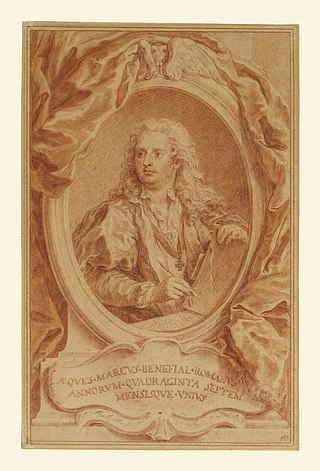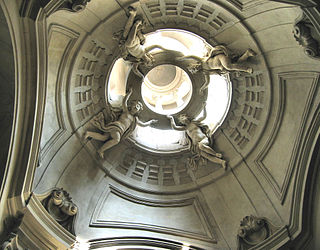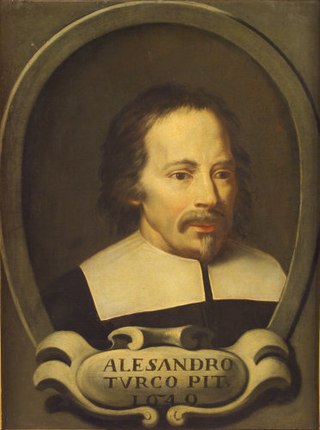
Carlo Saraceni was an Italian early-Baroque painter, whose reputation as a "first-class painter of the second rank" was improved with the publication of a modern monograph in 1968.

Sant'Ambrogio e Carlo al Corso is a basilica church in Rome, Italy, facing onto the central part of the Via del Corso. The apse of the church faces across the street, the Mausoleum of Augustus on Via di Ripetta.

There are more than 930 churches in Rome, which makes it the city with the largest number of churches in the world. Almost all of these are Catholic.

Carlo Maratta or Maratti was an Italian painter, active mostly in Rome, and known principally for his classicizing paintings executed in a Late Baroque Classical manner. Although he is part of the classical tradition stemming from Raphael, he was not exempt from the influence of Baroque painting and particularly in his use of colour. His contemporary and friend, Giovanni Bellori, wrote an early biography on Maratta.

Stefano Pozzi was an Italian painter, designer, draughtsman, and decorator whose career was spent largely in Rome.

Antonio Balestra was an Italian painter of the Rococo period.

Marco Benefial was an Italian, proto-Neoclassical painter, mainly active in Rome. Benefial is best known for his repudiation of 18th century decorative Rococo styles pre-eminent in the Rome dominated by Carlo Maratta pupils. His paintings portrayed tangible human figures, with complex treatment of space, and luminous, warm colors. Along with the altarpieces and frescoes, he also painted many portraits. Because he partnered with some inferior artists who subsequently received credit, some of his paintings have been frequently misidentified.

Giovanni Domenico Cerrini (1609–1681), also called Gian Domenico Cerrini or il Cavalier Perugino, was a painter of the Baroque period, born in Perugia and active mainly in Rome and influenced in large part by painters of the Bolognese School.

Giuseppe Bartolomeo Chiari, also known simply as Giuseppe Chiari, was an Italian painter of the late-Baroque period, active mostly in Rome.

Giacinto Brandi was an Italian painter from the Baroque era, active mainly in Rome and Naples.

Antonio Gherardi was an Italian painter, architect, and sculptor (stuccoist) of the Baroque style, active mainly in and near Rome and his native city of Rieti.

Alessandro Turchi was an Italian painter of the early Baroque, born and active mainly in Verona, and moving late in life to Rome. He also went by the name Alessandro Veronese or the nickname L'Orbetto. His style has been described as soft and Caravaggesque at the same time.

Luigi Garzi (1638–1721) was an Italian painter of the Baroque period whose style was strongly influenced by the work of the Bolognese painter Guido Reni.

Onorio Longhi (1568–1619) was an Italian architect, the father of Martino Longhi the Younger and the son of Martino Longhi the Elder.

Giovanni Battista Benaschi, or Beinaschi, (1636–1688) was an Italian painter and engraver active in the Mannerist and Baroque style.

Giovanni Battista Buonocore was an Italian painter of the Baroque period. He became Rector (1679), then Principe (1698) of the Accademia di San Luca of Rome.

Carlo Antonio Rambaldi (1680–1717) was an Italian painter of the Baroque period, active in his native Bologna.

Antonio Viviani (1560–1620) was an Italian painter of the late Renaissance and early Baroque.

San Carlo al Corso is a neoclassic style, Roman Catholic church located in the Piazza of San Carlo, just off Corso Vittorio Emanuele II, just west of the Piazza San Babila, in central Mila, region of Lombardy, Italy.

Francesco Mancini was an Italian painter whose works are known between 1719 and 1756. He was the pupil of Carlo Cignani.




















